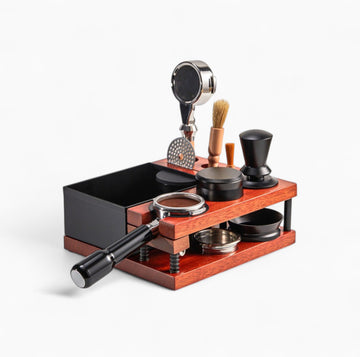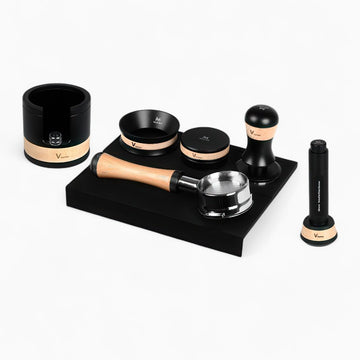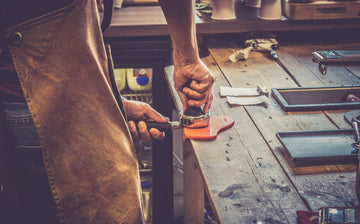Could tamping the Espresso make a real difference to your coffee taste? Of course, it can. Could I tamp without using a tamper? Yes, you can try other solutions when you do not own a tamper. Nevertheless, the results are not good enough as if you were using a true tamper. Let’s take a look at how you can tamp right.
What is tamping?
Tamping is pressing down the ground of coffee beans (Espresso) in a portafilter. It sounds simple to push down and push up, but it is so much more than that. This is a way of adding the proper amount of pressure (about 30 pounds of it) in order to make a puck of coffee cup.
Why is tamping the Espresso important?
Tamping your Espresso grounds plays a crucial role if you want to relish an amazing cup of coffee. This is because Espresso requires more fines in the grounds and the brewing process is quite short.
As you probably explored, Espresso is created by using high pressure to push the water through the coffee grounds. In other words, the contact with the coffee is pretty short. If you want to get an excellent coffee extraction for your Espresso shot, you will need to grind coffee beans thinly. Well, this is the only solution to extract more flavors in a short time. Find grounds that allow the hot water to extract coffee out of them.
Why do you need to tamp the coffee beans in a portafilter? This is because an Espresso machine produces about 9 bars of pressure. In other words, this is 9 times the air pressure that you are feeling on Earth.
When the water is pushed through the portafilter with that force, it will be pushed out if your coffee grounds do not tamp. For that reason, your coffee cup will be poor with a watery flavor only and maybe a little caffeine.
As the water moves with force, the coffee will be gone out and this process is called floating. The grounds will be moved aside and the portafilter will be full of water. The grounds then possibly float in and you cannot extract them anymore.
What is the true tamping pressure?
When finding the tamping pressure for your shot of Espresso, you will see a lot of options and advice on how much pressure should be done. Nonetheless, you do not need to follow all of them.
Simply remember a general rule of thumb. Press yours until the tamper cannot go any further. When the coffee grounds are fully compressed, pressure could not move the needle.
Most coffee lovers point out a specific amount of pressure from 20 to 30 pounds as ideal for tamping. You can try by using a scale and tamp your coffee on it. Another method is tamping your coffee until it pushes back.
Other people use a pressure calibrated tamper. Such a unit usually supports you to get the exact amount of tamping force. You will become an Espresso tamping expert and receive the best shot of Espresso with each brew.
How to tamp your Espresso without using a tamper
- Step 1: measure the level of the coffee grounds. Fill the coffee grounds in a portafilter (above the brim). You swipe the coffee over the top and remove excess coffee with your index finger. Please keep in mind that you should not push the grounds down with your hands to prevent uneven oils extraction and flavorless coffee.
- Step 2: adjust the position between your body and the tool. On a flat surface, you need to place the portafilter and create the pressure on it. Then, put the portafilter on a table if it has a flat surface. You can use the table’s edge to create the level. Place your body correctly to make sure that the tamping power generates from your body, not your wrist. Bend your elbow about 90 degrees of angle but remain your wrist straight.
- Step 3: use the light pressure to tamp. The light pressure can come with a pestle or a beer bottle. You add one of them on the grounds in the portafilter. 15 is the maximum level of bars. Do not apply more than 15 as the pestle or beer bottle reaches at 90 degrees to make a smooth level on the coffee.
- Step 4: apply more pressure. Observe the coffee grounds and ensure that they are evenly leveled. Then, you could add more pressure. Push down the coffee to diminish any space between them. Furthermore, you might increase the force up to 30 bars. Move the pestle or beer bottle in a circular motion. By doing this, you can polish the top.
- Step 5: check a puck inspection and clean the portafilter. Make sure that the puck does not come with any loose spot. After that, you remove any excess coffee grounds on the edge of a portafilter. It will protect the gasket.
Dangers in wrong tamping
Espresso tamping sounds easy, but you need to pay close attention to the process. This is because incorrect tamping probably causes awful taste for your shots.
- Under-tamping: if you get the light tamp, water will go through the coffee grounds immediately. Hence, you will have under-extraction with a weak and sour Espresso shot.
- Over-tamping: if you apply hard pressure, the water cannot go through the coffee grounds. The process will be over-extracted and your shot will be bitter and burnt.
- Uneven tamping: in this situation, the water will go out without control and cause uneven extraction. Your shot will be terrible because it has a confusing mix of under-extracted and over-extracted.
Alternative tools for a tamper
When you do not have a tamper, you can use other tools and devices to tamp your coffee shot.
- The back of a spoon: you need to find a solid teaspoon does the trick. Significantly pressure by the back of your spoon. Please bear in mind that you do not have to dig the coffee. Do not apply hard pressure on the coffee grounds.
- Small jars: small jars are good options with the flat bottom and they fit into a portafilter. Ensure that your small jars are empty and clean to tamp the coffee.
- The bottom of a shot glass: you will be surprised that the bottom of a shot glass will become a great solution for coffee tamping. It looks like a small tamper. Make sure that you control the pressure because the glass will not be broken.
- A measuring cup: a measuring cup is not only an alternative tamper but also a kitchen tool. A sturdy measuring cup could become a makeshift tamper.
- A thumb: once you do not have any tool to tamp, use your thumb. Move your thumb in a circular motion. Then, you move from a section to the next one with slight pressure. Be patient!
- The bottom of a beer bottle or soda bottle: this selection sounds a bit wild, but it may rescue you for a tamper. Grab the flat of a beer bottle (or a soda bottle) and compress the coffee grounds. Make sure that the bottom of these bottles are clean and position your body to make the right force.
- A small-sized can: from any can in your kitchen (from tomato paste cans to salsa ones), you can reuse them as a filter for your coffee grounds. Ensure that these cans are small, clean, and dry. Remove the label or the paper from the sides before tamping.
- A pill bottle: pill bottles can come with different sizes and shapes, so select the ones that fit the coffee grounds. You should check a few bottles before you choose the one that fits well.
FAQs
Is a tamper necessary?
The tamping is vital to make the right Espresso cup, but a temper is an optional only. You can select another tool to begin with your tamping.
Do I usually have to tamp Espresso?
Yes, you should do it.
How do I measure Espresso tamping pressure?
Follow those steps mentioned above. You even possibly try a kitchen scale if you are not confident. Make sure that the scale has at least 30 or 40 bars of pressure.
How do you know that you are tamping accurately?
The taste of your coffee cup after brewing. If your shot has an extreme and strong flavor, your tamping is right. If your coffee cup is burnt and bland, your tamping is wrong.
Key takeaway
Espresso tamping plays a vital role in the coffee brewing process. By doing this, it will ensure that your coffee is extracted out of the ground. The coffee will not be burned or floated. In case you do not have a tamper, you probably improvise something. Nonetheless, it will be trickier to get the right result (the coffee grounds).













